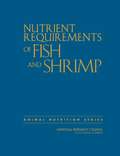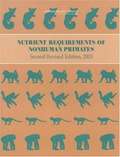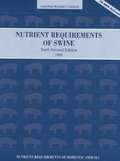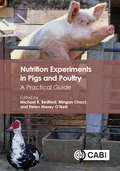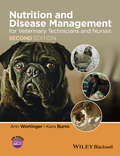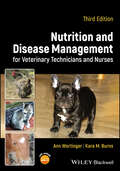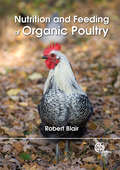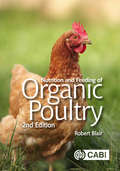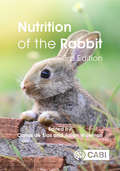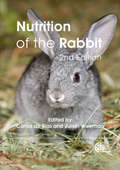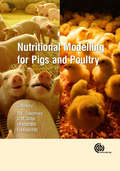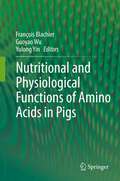- Table View
- List View
Nutrient Requirements of Fish and Shrimp
by Committee on the Nutrient Requirements of Fish ShrimpAquaculture now supplies half of the seafood and fisheries products consumed worldwide and is gaining international significance as a source of food and income. Future demands for seafood and fisheries products can only be met by expanded aquaculture production. Such production will likely become more intensive and will depend increasingly on nutritious and efficient aquaculture feeds containing ingredients from sustainable sources. To meet this challenge, Nutrient Requirements of Fish and Shrimp provides a comprehensive summary of current knowledge about nutrient requirements of fish and shrimp and supporting nutritional science. This edition incorporates new material and significant updates to information in the 1993 edition. It also examines the practical aspects of feeding of fish and shrimp. Nutrient Requirements of Fish and Shrimp will be a key resource for everyone involved in aquaculture and for others responsible for the feeding and care of fish and shrimp. It will also aid scientists in developing new and improved approaches to satisfy the demands of the growing aquaculture industry.
Nutrient Requirements of Laboratory Animals: Fourth Revised Edition, 1995
by Subcommittee on Laboratory Animal NutritionIn the years since the third edition of this indispensable reference was published, a great deal has been learned about the nutritional requirements of common laboratory species: rat, mouse, guinea pig, hamster, gerbil, and vole. The Fourth Revised Edition presents the current expert understanding of the lipid, carbohydrate, protein, mineral, vitamin, and other nutritional needs of these animals. The extensive use of tables provides easy access to a wealth of comprehensive data and resource information. The volume also provides an expanded background discussion of general dietary considerations. In addition to a more user-friendly organization, new features in this edition include: A significantly expanded section on dietary requirements for rats, reporting substantial new findings. A new section on nutrients that are not required but that may produce beneficial results. New information on growth and reproductive performance among the most commonly used strains of rats and mice and on several hamster species. An expanded discussion of diet formulation and preparation--including sample diets of both purified and natural ingredients. New information on mineral deficiency and toxicity, including warning signs. This authoritative resource will be important to researchers, laboratory technicians, and manufacturers of laboratory animal feed.
Nutrient Requirements of Nonhuman Primates: Second Revised Edition, 2003
by Committee on Animal NutritionThis new release presents the wealth of information gleaned about nonhuman primates nutrition since the previous edition was published in 1978. With expanded coverage of natural dietary habits, gastrointestinal anatomy and physiology, and the nutrient needs of species that have been difficult to maintain in captivity, it explores the impact on nutrition of physiological and life-stage considerations: infancy, weaning, immune function, obesity, aging, and more. The committee also discusses issues of environmental enrichment such as opportunities for foraging.Based on the world's scientific literature and input from authoritative sources, the book provides best estimates of nutrient requirements. The volume covers requirements for energy: carbohydrates, including the role of dietary fiber; proteins and amino acids; fats and fatty acids; minerals, fat-soluble and water-soluble vitamins; and water. The book also analyzes the composition of important foods and feed ingredients and offers guidelines on feed processing and diet formulation.
Nutrient Requirements of Swine: Tenth Revised Edition, 1998
by Subcommittee on Swine NutritionThe tenth edition of this essential reference presents new knowledge about the nutritional needs of swine that consider such factors as growth rate, carcass leanness, gender, health, environment, and repartitioning agents. New sections are presented on requirements for amino acids and other nutrients. In addition, an original modeling approach to arriving at energy and amino acid needs for given animals is incorporated in this revision. The book comes with a CD-ROM that allows users to create tables of nutrient requirements for swine of a specific body weight and level of productivity. Nutrient Requirements of Swine covers: Biological concepts that underlie nutrient needs for growth and function. New data on amino acid and energy requirements and the factors that shape them. New findings on lysine and the bioavailability of amino acids. New research results on minerals and vitamins. Nutrient composition of an expanded list of feedstuffs. The role of water in swine physiology, including factors that affect the quality of drinking water. Expanded tables of feed ingredients and their nutrient composition provide bioavailability estimates, fatty acid composition of fats typically used in swine diets, and important information on estimating the amino acid content of crude protein.
Nutrition Experiments in Pigs and Poultry a Practical Guide
by Michael R. Bedford Mingan Choct Helen V. Masey O'NeillThis practical research text provides an invaluable resource for all animal and veterinary scientists designing, analyzing and interpreting results from nutrition and feed experiments in pigs and poultry. The emphasis throughout is on practical aspects of designing nutrition experiments. The book builds on the basics and proceeds to describe the limitations of experiment design involving different ingredients. It then characterizes experimental diets including ingredient selection, composition and the minimum proximate analysis required. The text details measurements and the tools available for understanding diverse data sets, data analysis and the eventual publication of the research. This fully balanced and extensively referenced, yet practical, text is an invaluable resource to all animal, veterinary and biomedical scientists involved in the designing of nutrition experiments in pigs and poultry, and the publication of their research.
Nutrition Experiments in Pigs and Poultry: A Practical Guide
by Michael R. Bedford Mingan Choct Helen V. Masey O’NeillThis practical research text provides an invaluable resource for all animal and veterinary scientists designing, analysing and interpreting results from nutrition and feed experiments in pigs and poultry. The emphasis throughout is on practical aspects of designing nutrition experiments. The book builds on the basics and proceeds to describe the limitations of experiment design involving different ingredients. It goes on to describe the characterization of experimental diets including ingredient selection, composition and the minimum proximate analysis required. The text details measurements and the tools available for understanding diverse data sets, data analysis and eventual publication of the research. This fully balanced and extensively referenced, yet practical, text is an invaluable resource to all animal, veterinary and biomedical scientists involved in the designing of nutrition experiments in pigs and poultry, and the publication of their research.
Nutrition and Disease Management for Veterinary Technicians and Nurses
by Ann Wortinger Kara BurnsNutrition and Disease Management for Veterinary Technicians and Nurses, Second Edition offers a thorough update and significant expansion of this easy-to-use introduction to veterinary nutrition and diet, with broader species coverage, a new section on nutritional management of disease, and many new chapters. * Provides a complete reference to veterinary nutrition, from the fundamentals to feeding companion animals of any age and health status * Adds information on nutrition in birds, small mammals, and horses to the existing dog and cat coverage * * Presents a new section on managing disease through nutrition, with 10 new disease chapters * Offers additional new chapters on nutritional calculations, types of pet foods, raw food diets, additives and preservatives, nutrition myths, nutritional support, and assisted feeding * Includes access to a companion website with case studies, review questions and answers, and the figures from the book in PowerPoint
Nutrition and Disease Management for Veterinary Technicians and Nurses
by Ann Wortinger Kara M. BurnsNutrition and Disease Management for Veterinary Technicians and Nurses A fully updated edition of the student-friendly guide to veterinary nutrition Diet and nutrition are essential aspects of veterinary care. Proper care and feeding of companion animals can improve health outcomes and help to prevent disease. Meeting the altered dietary needs of a sick animal can facilitate recovery and improve quality of life. For veterinary technicians, nurses, and other veterinary practitioners, a working knowledge of companion animal nutrition is an essential component of overall patient care. Nutrition and Disease Management for Veterinary Technicians and Nurses offers an accessible, up-to-date introduction to the key concepts and elements of veterinary nutrition. With detailed coverage of the fundamentals of veterinary nutrition in addition to the nutritional management for many common small animal diseases, the third edition incorporates all the essentials of veterinary nutrition and dietary management for veterinary patients of any age or health status. Readers of the third edition of Nutrition and Disease Management for Veterinary Technicians and Nurses will also find: Fourteen new chapters, plus additional species in some chapters An added section on prebiotics, probiotics, and synbiotics End-of-chapter summaries with multiple-choice questions and case reviews to facilitate use in the classroom Nutrition and Disease Management for Veterinary Technicians and Nurses is ideal for all veterinary technician students, working veterinary technicians, nurses, and students working towards specialty certification in veterinary nutrition.
Nutrition and Feeding of Organic Pigs
by Robert BlairA comprehensive text on feeding organic pigs, this book presents advice on formulating appropriate diets and integrating them into organic pig production systems. It outlines the international standards of organic feeding, the breeds of pig that are most suitable for organic farming, up to date information on the nutritional requirements of pigs, and examples of diets formulated to organic standards.
Nutrition and Feeding of Organic Pigs
by Robert BlairOrganic animal production has increased rapidly in recent years to keep up with the increasing consumer demand for organic meats. There are many guidelines and restrictions on what should go into the feedstuffs of organically farmed animals, from which difficulties arise when trying to ensure a well-balanced, nutritious diet without the use of any supplements. This second edition of Robert Blair's classic and bestselling book on the nutrition and feeding of organic pigs presents comprehensive advice that includes: - formulating appropriate diets and integrating them into organic pig production systems; - international standards of organic feeding; - feed-related disease incidence in organic herds. The book has been completely updated and revised to address how to formulate organic diets in situations where there is a declining supply of organic feed, as well as the feasibility of utilizing novel feedstuffs and their acceptability by consumers of organic meat products. Including the experiences of producers in relation to appropriate breeds and production systems for forage-based organic production, this book is an important read for researchers and students of organic food animal production, veterinary sciences and food; as well as food industry personnel and organic farmers.
Nutrition and Feeding of Organic Pigs
by Robert BlairOrganic animal production has increased rapidly in recent years to keep up with the increasing consumer demand for organic meats. There are many guidelines and restrictions on what should go into the feedstuffs of organically farmed animals, from which difficulties arise when trying to ensure a well-balanced, nutritious diet without the use of any supplements. This second edition of Robert Blair's classic and bestselling book on the nutrition and feeding of organic pigs presents comprehensive advice that includes: - formulating appropriate diets and integrating them into organic pig production systems; - international standards of organic feeding; - feed-related disease incidence in organic herds. The book has been completely updated and revised to address how to formulate organic diets in situations where there is a declining supply of organic feed, as well as the feasibility of utilizing novel feedstuffs and their acceptability by consumers of organic meat products. Including the experiences of producers in relation to appropriate breeds and production systems for forage-based organic production, this book is an important read for researchers and students of organic food animal production, veterinary sciences and food; as well as food industry personnel and organic farmers.
Nutrition and Feeding of Organic Poultry
by Robert BlairOrganic poultry production has increased significantly in recent years in response to increasing consumer demand for organic eggs and meat. Nutrition and Feeding of Organic Poultry is the first comprehensive text on feeding organic poultry, presenting advice on selecting suitable ingredients, preparing appropriate feed mixtures and integrating them into organic poultry production systems. The international standards of organic feeding, the species and breeds of poultry most suitable for organic farming, up-to-date information on the nutritional requirements of poultry and examples of diets formulated to organic standards are all discussed.
Nutrition and Feeding of Organic Poultry
by Robert BlairOrganic poultry production has increased significantly in recent years to keep up with increasing consumer demand for organic eggs and meat. There are many guidelines and restrictions on what should go into the feed of organically-farmed poultry, from which difficulties arise when trying to ensure a well-balanced nutritious diet without the use of any unapproved supplements. This, the second edition of Robert Blair's classic and bestselling book on the nutrition and feeding of organic poultry, presents advice for organic producers, and the agencies and organizations serving them. It covers: - Selecting suitable ingredients. - Preparing appropriate feed mixtures and integrating them into organic poultry production systems. - International standards for organic feeding. - Breeds that are most suitable for organic farming. - Examples of diets formulated to organic standards. Completely updated and revised to address how to formulate organic diets in situations where there is a declining supply of organic feed, this new edition also includes up-to-date information on the nutritional requirements of poultry and feed-related disease incidence in organic flocks. Also including the feasibility of utilizing novel feed, such as insect meal, and their acceptability by consumers of organic meat products, this book forms a comprehensive reference for students, organic farmers, veterinarians and researchers.
Nutrition and Feeding of Organic Poultry
by Robert BlairOrganic poultry production has increased significantly in recent years to keep up with increasing consumer demand for organic eggs and meat. There are many guidelines and restrictions on what should go into the feed of organically-farmed poultry, from which difficulties arise when trying to ensure a well-balanced nutritious diet without the use of any unapproved supplements. This, the second edition of Robert Blair's classic and bestselling book on the nutrition and feeding of organic poultry, presents advice for organic producers, and the agencies and organizations serving them. It covers: - Selecting suitable ingredients. - Preparing appropriate feed mixtures and integrating them into organic poultry production systems. - International standards for organic feeding. - Breeds that are most suitable for organic farming. - Examples of diets formulated to organic standards. Completely updated and revised to address how to formulate organic diets in situations where there is a declining supply of organic feed, this new edition also includes up-to-date information on the nutritional requirements of poultry and feed-related disease incidence in organic flocks. Also including the feasibility of utilizing novel feed, such as insect meal, and their acceptability by consumers of organic meat products, this book forms a comprehensive reference for students, organic farmers, veterinarians and researchers.
Nutrition and Metabolism of Dogs and Cats (Advances in Experimental Medicine and Biology #1446)
by Guoyao WuThis book provides new knowledge about the nutrition and metabolism, as well as the roles of nutrients in the immunity, health, and management of companion animals (dogs and cats). The domestic dog (facultative carnivore) and the domestic cat (obligate carnivore) have evolved differentially in their digestive tract, nutrition, metabolism, chemical sensing, and feeding behavior. These animals have been human companions for at least 12,000 and 9,000 years, respectively, and continue to contribute to the mental health and well-being of children, adolescents, and adults. Both dogs and cats have become increasingly popular in many countries and worldwide over the past decades. Comprehensive update about how the animals utilize dietary nutrients for optimum growth, development, and health is beneficial for their owners, as well as students and researchers. Chapter 4: Characteristics of Nutrition and Metabolism in Dogs and Cats is available open access under a Creative Commons Attribution 4.0 International License
Nutrition and the Welfare of Farm Animals
by Clive J. C. PhillipsThis book explores the importance of good nutrition in ensuring an adequate standard of welfare for farm animals. It is often not realized that farm animals can suffer when they are fed unsuitable diets, which may be because these diets are more economic or the farmer does not know how to rectify poor nutrition. This book reveals how to recognize and deal with feeding problems in farm animals, when the animal's behaviour is indicating a deficiency, through oral stereotypies for example. Feeding livestock in emergency situations can present special challenges, and the availability of clean and potable water, one of the essential components of life, can also be an unrecognized problem for many farm animals. Feeding farm animals effectively is rarely recognized for the major welfare issue that it is. We may assume that animals in intensive husbandry conditions have adequate feed, yet it is often too concentrated and designed primarily to immediately maximize production from the animals, in the form of growth, milk yield or reproduction. In extensive rangeland conditions adequate feed supply also cannot be assured, potentially leading to undernutrition with serious consequences for the health and even survival of livestock. This book will provide a much-needed review of the relationships between nutrition and the welfare of farm animals.
Nutrition for Veterinary Technicians and Nurses
by Ann WortingerThis book serves an introduction to the fundamentals of nutrition and also a guide to monitoring the nutritional needs of patients in daily practice. Students will benefit from the clear and consistent approach to basic principles of nutrition. Practicing technicians and nurses will appreciate the practical applications and techniques for managing the nutritional needs of both sick and healthy patients and guidance for educating clients.
Nutrition of the Rabbit
by John Lowe R Carabano R. Abad-Guamán D Allain I. Badiola E Blas C Cervera A. Dalle Zotte J. Fernández Carmona S. Gy. Fekete L. Fortun-Lamothe M. J. Fraga J García T Gidenne P Hernández F. Lebas D. Licois Luc Maertens G Mateos J Méndez D. Menoyo N. Nicodemus J. Piquer P. G. Rebollar G. Santomá R. G. Thébault A. Trocino M Villamide G XiccatoBringing together international expertise in rabbit production, topics covered in this fully updated volume include digestive physiology, feed formulation and product quality, as well as feeding strategies, feed processing, feed management around weaning and the relationship between nutrition and intestinal health. Brand new to this edition, the chapters also discuss the development of immune response and the role of intestinal microbiota, new dietary sources and additives, and feeding behaviour in pasture and organic feeding. A valuable resource for researchers and students of animal nutrition and production, this book provides a comprehensive, research-based review of nutrition for these important animals.
Nutrition of the Rabbit (2nd edition)
by Carlos De Blas Julian WisemanTopics covered in this authoritative volume include digestive physiology, feed formulation and product quality as well as new contributions on innovative feeding strategies, new methods for feed processing, feed management around weaning and the relationship between nutrition and intestinal health.
Nutritional Management of Equine Diseases and Special Cases
by Bryan M. WaldridgeNutritional Management of Equine Diseases and Special Cases offers a concise, easy-to-comprehend text for equine veterinarians with questions about commonly encountered nutritional problems. Assists veterinarians in supporting equine patients with special nutritional needs Focuses on nutritional problems and impact on different body systems Covers ponies, miniature horses, draft horses, donkeys, and mules Offers complete coverage of common diseases and problems helped by nutrition Includes useful chapters on poisonous plants and mycotoxins
Nutritional Management of Hospitalized Small Animals
by Daniel ChanNutritional Management of Hospitalized Small Animals offers veterinarians, veterinary students and technicians a comprehensive reference to the latest information relating to the principles and practice of nutritional support in small animals that require hospitalization. Represents the definitive resource for small animal veterinarians in providing optimal nutritional support for their patients during hospitalization Discusses and demonstrates the most up-to-date techniques available for successfully implementing nutritional support for hospitalized small animal patients Provides step-by-step pictorial instructions on how to implement the most appropriate techniques for particular patients Reveals expected outcomes and possible complications along with strategies to minimize risk of complications
Nutritional Modelling for Pigs and Poultry
by Colin Fisher Frank Frank Ilias Kyriazakis Jean-Yves Jean-Yves Nilva K Sakomura Juliano C Juliano C P Daniella C.Z. Daniella C.Z. Melina A Melina A Edney Pereira Edney Pereira L Hauschild Hilda C Hilda C P Rob Gous Virginie Virginie Normand Normand Edgar Edgar Nilva K Sakmoura Candido Candido Jaap Jaap Neil S Neil S Antonio Sergio Antonio SergioModelling is a useful tool for decision making in complex agro-industrial scenarios. Containing a selection of the papers presented at the International Symposium of Modelling in Pig and Poultry Production 2013, this book brings together the best and most recent academic work on modelling in the pig and poultry industry, with a particular emphasis on nutrition. It reviews basic modelling concepts, descriptions and applications of production models and new methods and approaches in modelling.
Nutritional Modelling for Pigs and Poultry
by Colin Fisher Frank Frank Jean-Yves Jean-Yves Nilva K Sakomura Juliano C Juliano C P Daniella C.Z. Daniella C.Z. Melina A Melina A Edney Pereira Edney Pereira Hilda C Hilda C P Virginie Virginie Normand Normand Edgar Edgar Candido Candido Jaap Jaap Neil S Neil S Antonio Sergio Antonio SergioModelling is a useful tool for decision making in complex agro-industrial scenarios. Containing a selection of the papers presented at the International Symposium of Modelling in Pig and Poultry Production 2013, this book brings together the best and most recent academic work on modelling in the pig and poultry industry, with a particular emphasis on nutrition. It reviews basic modelling concepts, descriptions and applications of production models and new methods and approaches in modelling.
Nutritional and Physiological Functions of Amino Acids in Pigs
by Francois Blachier Guoyao Wu Yulong YinThis book provides developmental data regarding piglets (with a focus on the gastrointestinal tract), data related to amino acid metabolism in pigs, data related to nutritional and physiological functions of amino acids in pigs, nutritional requirements for amino acids in pigs, signaling roles of amino acids, methodological aspects in amino acid research and the pig model for studying amino acid-related human diseases.
Nuts to You
by Lynne Rae PerkinsHow far would you go for a friend? In Nuts to You, the funny and moving new novel by Newbery Medalist Lynne Rae Perkins, two squirrels go very far indeed to save a friend who has been snatched up by a hawk. Nuts to You is short, funny, and surprising--an Incredible Journey with squirrels. It features black-and-white art by the author on every page and will appeal to fans of animal fantasies by Kate DiCamillo, Kathi Appelt, and Avi.The squirrels Jed, TsTs, and Chai are the very best of friends. So when Jed is snatched up by a hawk and carried away to another realm, TsTs and Chai resolve to go after him. New communities are discovered, new friends are made, huge danger is encountered (both man-made and of the fox and bobcat variety) and mysteries are revealed. Nuts to You is wholly original, funny, lively, and thought-provoking. It is a deeply satisfying piece of storytelling about the power of stories to save the world; about the power of friendship and the importance of community.This beautiful book is illustrated in black-and-white on every page by the author and includes an introduction, epilogue, and funny footnotes throughout. A terrific read aloud!
